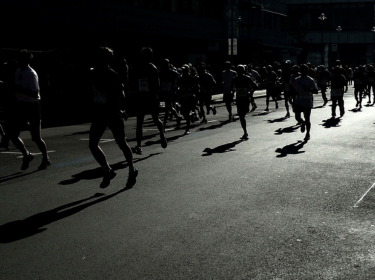Hitting the Wall Phenomenon: Fatigue Before the Finish Line
You are running a marathon. Everything is going well, and all of a sudden it isn’t. You hit the 19-mile mark, and you start to feel immensely exhausted. Your pace slows down, and you feel like you are running into a wall. Your legs feel overly heavy, and you have to use every ounce of energy in your body to move towards the finishing line.
This phenomenon is commonly called ‘hitting the wall’ and is experienced by marathoners usually around the 20-mile mark. It is caused by the depletion of your body's energy sources, leading to a significant decrease in pace during the latter part of the race1.
Glycogen, a carbohydrate stored in your muscles, is the body’s main source of energy for long-distance running. The exhaustion experienced during this time (around the 20-mile mark) is attributed to the depletion of glycogen levels. This causes both mental as well as physical fatigue. Running a marathon takes an invariable amount of resources and energy. Towards the end of the marathon, the body’s energy resources start to deplete, and ‘hitting the wall’ is the way that the brain instructs the muscles to tense so that the body slows down.
How long does this phenomenon last? This is a common question when discussing the concept. Once a runner hits the wall, the feeling of exhaustion lasts for the remainder of the marathon. In other words, it is very difficult to reverse the effects, although there are a few things that can be done to recover. While a good nutrition regimen and an effective training program are crucial, it is also important to emphasise psychological interventions that can be introduced to avoid it in the first place.
Here are two strategies that might be helpful in delaying or even preventing this experience:
1. Shifting your attentional focus
Shifting the attentional focus can help runners cope with hitting the wall2. Attentional focus can be on associative or dissociative thoughts. Associative thoughts include thoughts that are related to the task at hand, in this case, running. This includes thoughts related to pace and breath. On the other hand, dissociative thoughts include thoughts that are irrelevant to the task at hand, and include daydreams, focusing on the crowd, or the situation around. Associative and dissociative thoughts can be used in different situations in different ways.
Internal thoughts are the thoughts that are directed towards your internal mental and physical sensations. External thoughts are directed outside of one’s body towards external cues. A combination of the above-mentioned thoughts makes four broad dimensions of how attention can be shifted and focused. They are internal dissociative (ID), internal associative (IA), external dissociative (ED), and external associative (EA). Here are examples that can be followed to understand the concept:
If you experience exhaustion or fatigue when running, and your mind is occupied with thoughts about the run (IA), shift your attention to an external situation like the path or road, the people around you, the buildings, and other objects you pass (ED). By shifting your attention from the mental and physical sensations you experience to external cues, you distract yourself from the unpleasant feelings of fatigue and the negative thoughts that may accompany it. You can also focus your attention on internal aspects like your breath, pace (IA), or a random daydream (ID). This can be effective in overcoming the feeling of exhaustion that would have otherwise built up over time.
2. Engaging in helpful self-talk
Everyone engages in self-talk, but keeping a few statements ready to use in challenging situations is an effective strategy. Helpful self-talk can be motivational and encouraging or instructional in nature3, and can help avoid the intrusion of unhelpful thoughts that increase the likelihood of hitting the wall. Self-talk has a cognitive effect that increases our belief in our ability to perform the task at hand. To engage in helpful self-talk, follow the steps below:
- Notice the thoughts and statements that enter your mind when you are running. Some of these may be unhelpful to you in that situation, whereas others might be helpful or even neutral. At the end of your run, write down the unhelpful thoughts in a notebook, in the same way as they crossed your mind. This increases awareness about the frequency of these thoughts and may also help you identify situations that trigger these unhelpful thoughts. Example: Saying “My muscles burn, I cannot do this anymore!” to yourself sometime after the 15-mile mark.
- Next, reframe your unhelpful self-talk to make it more helpful in that situation. Example: “I have done this before, I have trained for this, I can do it”.
- Use your prepared self-talk to cope with challenging situations throughout your run.
- Finally, remember that practice is key. Just as you regularly train yourself physically and technically, include your new mental strategy in every training session and run.
To conclude, while running a marathon, the body requires a number of resources, both physiological and psychological. Runners who train all aspects responsible for performance are less likely to experience this phenomenon and are in a better position to cope with these challenges along the way.
Written by Staley Putnam and Saniya Jain
Bibliography
